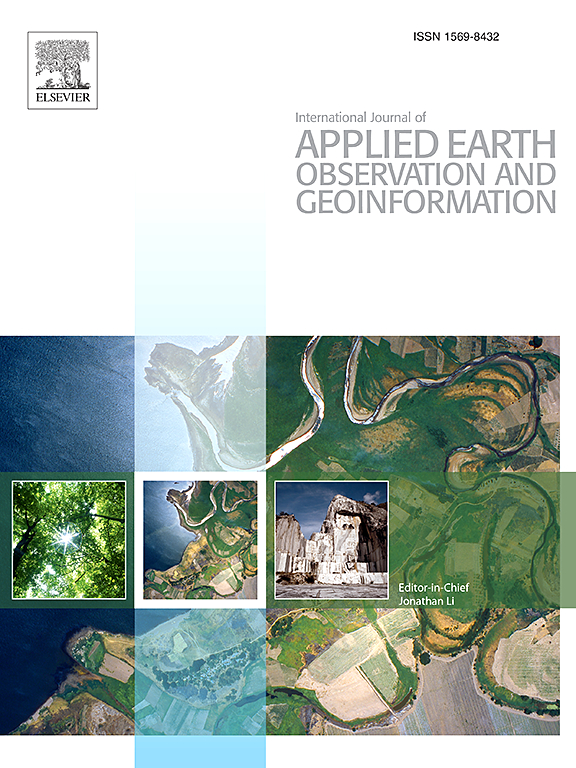城市灰绿尺度:动态空间权衡评估的新视角
IF 7.6
Q1 REMOTE SENSING
International journal of applied earth observation and geoinformation : ITC journal
Pub Date : 2025-07-03
DOI:10.1016/j.jag.2025.104708
引用次数: 0
摘要
城市化形成了城市灰色空间与绿色空间之间的动态关系,这种关系将深刻影响城市系统的稳定性和可持续性。然而,对城市灰绿空间协调的复杂动态、空间格局及其主导因素的研究较少。因此,本研究提出了灰色绿地权衡指标(GGSCI)来评价城市建成区发展过程中植被区与非植被区之间的动态关系。采用GGSCI对1990 - 2020年中国北方干旱区121个城市的城市增长动态进行了评价。采用Mean-Kendall趋势分析方法捕捉城市绿化的典型特征,并结合可解释的机器学习模型揭示社会经济指标和自然环境指标对GGSCI的相对贡献。结果表明:1990 ~ 2020年,非国大建成区面积扩大了5.72倍;总灰空间增长是绿地增长的2.12倍。此外,非国大灰色与绿色空间的关系正从不平衡走向平衡,不平衡城市的比例从23.28%的最大值下降到0%。城市中心绿化的趋势是显著的。在城市化不同阶段,社会经济和自然环境是影响GGSCI变化的主导因素,其中AAP和NL的贡献最大,分别为22.24%和20.21%。本文章由计算机程序翻译,如有差异,请以英文原文为准。

Urban grey-green scales: A new perspective for assessing dynamic spatial trade-offs
Urbanization has shaped a dynamic relationship between urban grey and green spaces, and this relationship will profoundly affect the stability and sustainability of the urban system. However, few studies have focused on the complex dynamics, spatial patterns, and dominant factors of the coordination between urban grey and green spaces. Therefore, this study develops a grey-green space trade-offs indicator (GGSCI) to assess the dynamic relationship between vegetated and non-vegetated areas during the growth of urban built-up areas. The GGSCI is implemented to evaluate the long-term dynamics of urban growth across 121 cities in the arid zone of northern China (ANC) from 1990 to 2020. We use Mean-Kendall trend analysis methods to capture the typical features of urban greening, and an interpretable machine learning model is combined to reveal the relative contributions of socioeconomic and natural environment indicators to the GGSCI. The results indicate that: the built-up area of ANC has expanded by 5.72 times from 1990 to 2020. Total grey space growth is 2.12 times that of green space. In addition, the relationship between grey and green spaces in ANC is moving from imbalance to balance, with the percentage of cities in imbalance dropping from a maximum of 23.28 % to 0 %. The trend of greening in urban centers is remarkable. We also reveal that socioeconomic and natural environment alternated as the dominant factors influencing changes in the GGSCI at different stages of urbanization, with AAP and NL contributing the most at 22.24 % and 20.21 %, respectively.
求助全文
通过发布文献求助,成功后即可免费获取论文全文。
去求助
来源期刊

International journal of applied earth observation and geoinformation : ITC journal
Global and Planetary Change, Management, Monitoring, Policy and Law, Earth-Surface Processes, Computers in Earth Sciences
CiteScore
12.00
自引率
0.00%
发文量
0
审稿时长
77 days
期刊介绍:
The International Journal of Applied Earth Observation and Geoinformation publishes original papers that utilize earth observation data for natural resource and environmental inventory and management. These data primarily originate from remote sensing platforms, including satellites and aircraft, supplemented by surface and subsurface measurements. Addressing natural resources such as forests, agricultural land, soils, and water, as well as environmental concerns like biodiversity, land degradation, and hazards, the journal explores conceptual and data-driven approaches. It covers geoinformation themes like capturing, databasing, visualization, interpretation, data quality, and spatial uncertainty.
 求助内容:
求助内容: 应助结果提醒方式:
应助结果提醒方式:


